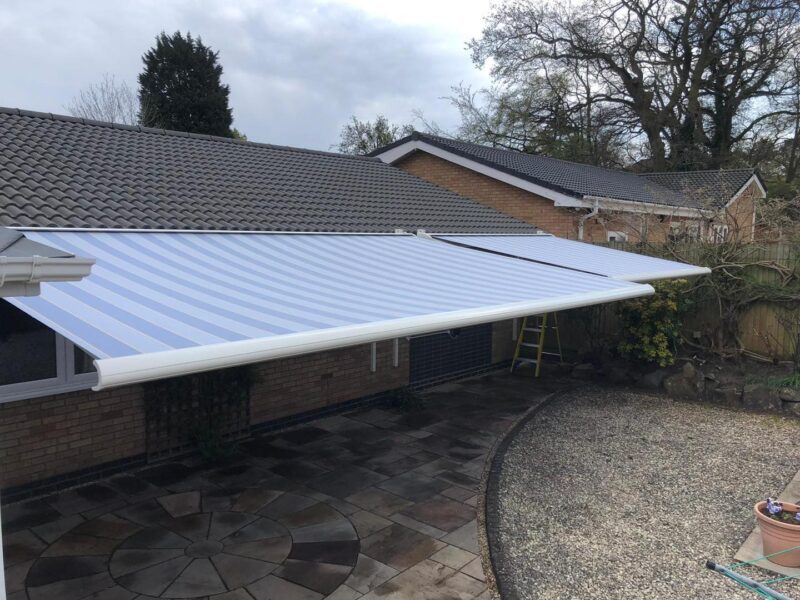How to Properly Maintain Your Awning During Winter
As the colder months approach, many homeowners start to prepare their homes for winter, but one area that often gets overlooked is the outdoor awning.
Awnings, which provide shade and protection during warmer months, can suffer significant damage if not properly maintained during winter. With heavy rain, snow, and icy conditions, it’s crucial to care for your awning to ensure it remains in good condition when spring comes around.
This guide, provided by us at Fraser James Blinds, will walk you through how to properly clean, maintain, and, if necessary, store your awning during the winter months.
Understanding Winter’s Impact on Your Awning
Winter weather can be particularly harsh on outdoor structures like awnings. Rain, snow, ice, and wind all pose risks that can weaken or damage both the fabric and the frame.
Furthermore, continuous exposure to moisture can lead to mould and mildew, while heavy snow and ice can cause the awning to sag or even tear under pressure. Wind can further exacerbate these issues by pushing the fabric and frame beyond their intended capacity.
The combination of these winter elements makes it clear that a lack of proper maintenance can reduce the lifespan of your awning. By preparing for and addressing these challenges, you can protect your investment and keep your awning looking great for years to come.
Start with a Thorough Cleaning Before Winter
One of the best ways to prepare your awning for the winter is to clean it thoroughly before the cold sets in. Dirt, debris, bird droppings, and mildew that accumulate during the warmer months can cause additional problems if left unchecked through winter.
Begin by brushing off any loose dirt and leaves with a soft broom or brush, making sure to be gentle to avoid damaging the fabric.
Once the surface is clear, mix mild soap with warm water and scrub the fabric using a soft brush. Harsh chemicals should be avoided as they can degrade the material over time. After cleaning, rinse the awning thoroughly with a garden hose to remove any remaining soap.
Remember to allow the awning to air dry completely before proceeding. Storing or retracting a damp awning can lead to mould and mildew growth, which can be difficult to remove later.
It’s equally important to clean the frame of your awning. Use the same mild soapy water to wipe down the structure, paying special attention to joints and hinges where dirt and grime can accumulate.
If the frame is made of metal, check for any rust spots, sanding them down gently and applying a rust-resistant primer to prevent further damage.
Inspect and Repair Any Damage
Once your awning is clean, the next step is to inspect it for any signs of wear and tear. Winter weather will only worsen existing problems, so it’s important to address them early.
Examine the fabric closely for holes, tears, or areas where it has begun to thin. Small issues like these can be patched with fabric repair tape, but for more significant damage, you may need to replace sections of the fabric or seek professional repair services.
The frame should also be inspected for any bent or loose components. Joints and connections are often stressed during windy conditions, so make sure all bolts and screws are tightened.
If you notice any structural damage, such as cracks in the frame, consider replacing the damaged parts before winter hits. Additionally, lubricating the moving parts of retractable awnings with a silicone-based spray can prevent them from freezing up in cold temperatures and keep the mechanism working smoothly.
Retract or Store Your Awning for Winter
If you live in an area with harsh winter conditions, it might be a good idea to retract or store your awning during the colder months. For retractable awnings, whether electric or manual, this is a simple way to protect both the fabric and frame from the elements.
Before retracting your awning, make sure it is completely dry to prevent moisture from getting trapped, which can cause mould. If your awning doesn’t already have a protective cover, consider purchasing one to shield the retracted awning from rain, snow, and UV damage.
For fixed awnings, storing them during the winter can offer an even greater level of protection. Begin by carefully disassembling the awning according to the manufacturer’s instructions. Be mindful not to bend the frame or tear the fabric during this process.
Store the fabric in a cool, dry place, making sure it’s rolled loosely to prevent creases or damage. Avoid storing it in plastic, as this can trap moisture, leading to mildew. The frame should be stored in a dry location as well, ideally after being disassembled for easier storage.
Ongoing Winter Maintenance for Fixed Awnings
Not all awnings are retractable or removable, and if yours falls into this category, you’ll need to perform ongoing maintenance throughout the winter to protect it from snow and ice.
After a heavy snowfall, be sure to clear the snow from your awning as soon as possible. Allowing snow to accumulate can cause the fabric to sag or even tear from the weight. Use a soft broom to gently remove the snow. Avoid using sharp tools like shovels or ice scrapers, as these can easily damage the fabric.
Ice buildup can be another concern during the winter months. Ice forms when snow melts and refreezes, which can create layers that weigh down the awning and damage the frame.
To prevent this, remove snow during sunny winter days to prevent melting and refreezing. If ice does form, it’s best to allow it to melt naturally, as trying to chip it away can cause tears in the fabric or harm the frame.
Protecting Your Awning from Wind Damage
High winds can also pose a threat to your awning during winter. If you have a retractable awning, be sure to secure it properly after retracting it to prevent it from being blown open.
Fixed awnings can be reinforced with additional tie-downs to keep them stable during particularly windy conditions. Regularly check to make sure your awning is securely fastened and that no parts have come loose after strong gusts of wind.
Conclusion: Caring for Your Awning Year-Round
Properly maintaining your awning during winter is an important step in prolonging its life and ensuring that it remains a functional and attractive part of your outdoor space.
By cleaning it thoroughly, inspecting and repairing any damage, and retracting or storing it when necessary, you can protect your awning from the harsh elements of winter. For fixed awnings, ongoing maintenance like clearing snow and ice will prevent more significant damage.
With the right care and attention, like what has been detailed in our guide, your awning will be ready to provide shade and comfort when the warmer months return, and you’ll avoid the costly repairs that can come from neglecting it during winter.
At Fraser James Blinds, our professional team is always on hand to help, so if you have any questions then simply contact us and we will be happy to assist you. Alternatively, should you prefer to arrange a home visit, you can easily do so at a time that works best for you.










